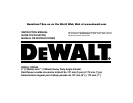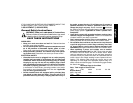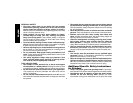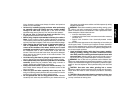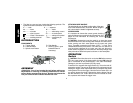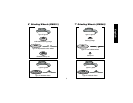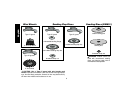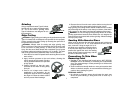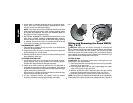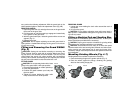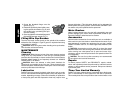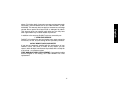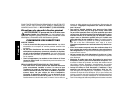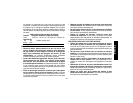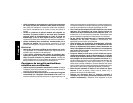
English
7
Grinding
Using a depressed center Type 27 wheel,
hold the tool at an angle of approximately
10˚- 30° to the work for grinding. Most
Type 27 wheels are not designed for cut-
ting operations.
Edge Cutting
WARNING: Edge grinding and cutting can be performed only with
Type 27 wheels that are designed and specified for this purpose.
Protect yourself during edge cutting by directing the open side of
the guard toward a surface.
WARNING: Wheels used for cutting and edge grinding may
break or kick back if they bend or twist while the tool is being used
to do cut-off work or deep grinding. To reduce the risk of serious
injury, limit the use of these wheels with a standard Type 27 guard
to shallow cutting and notching (less than 1/2" in depth). The open
side of the guard must be positioned away from the operator.
1. Allow the tool to reach full speed before touching the tool to the
work surface.
2. Apply minimum pressure to the work surface, allowing the
tool to operate at high speed. Grinding
rate is greatest when the tool operates
at high speed.
3. Position yourself so that the open-
underside of the wheel is facing away
from you.
4. Once a cut is begun and a notch is
established in the workpiece, do not
change the angle of the cut. Changing
the angle will cause the wheel to bend
and may cause wheel breakage.
5. Remove the tool from the work surface before turning the tool
off. Allow the tool to stop rotating before laying it down.
Edge grinding and cutting wheels should contact the work surface
only at the edge of the wheel, not on the top or bottom of the wheel.
Side pressure on the wheel could lead to breakage of the wheel.
WARNING: Do not use edge grinding/cutting wheels for surface
grinding applications because these wheels are not designed for
side pressures encountered with surface grinding. Wheel breakage
and injury may result.
Sanding With Abrasive Discs
When using an abrasive disc and rubber backing pad, hold the tool
so that an angle of 10° to 15° exists between the disc and the
work, as shown. Using an angle of 5˚ to 15˚
will allow you to produce a smooth surface.
If only the outer edge of the sanding disc is
pressed flat against the work, the sanding
action will be irregular and bumpy, and the
tool will be difficult to control.
Precautions To Take When
Removing Paint
1. Sanding or wire brushing lead based paint is NOT RECOM-
MENDED due to the difficulty of controlling the contaminated
dust. The greatest danger of lead poisoning is to children and
pregnant women.
2. Since it is difficult to identify whether or not a paint contains lead
without a chemical analysis, we recommend the following pre-
cautions when sanding any paint:
PERSONAL SAFETY
1. No children or pregnant women should enter the work area
where the paint sanding is being done until all clean up is
completed.
5˚ - 15°
10˚ - 30°



